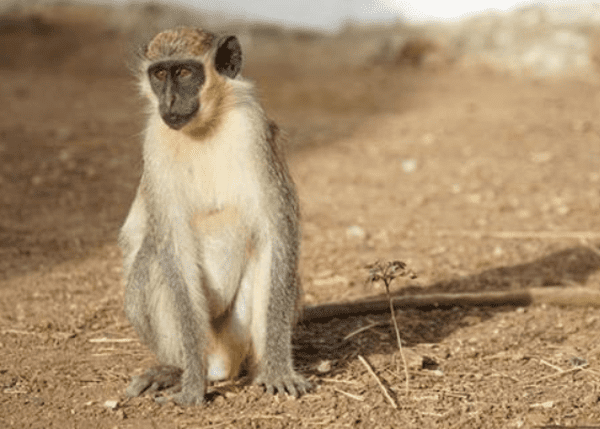Chlorocebus cynosuros
IUCN
LCBasic Information
Scientific classification
- name:Chlorocebus cynosuros
- Scientific Name:Chlorocebus cynosuros,Malbrouck Monkey,Angola black-faced green monkey
- Outline:Primates
- Family:Cercopithecidae G.Monkey
Vital signs
- length:30-60cm
- Weight:3.4-13kg
- lifetime:No verification information
Feature
Black cheeks, flesh-colored spots under eyes, hairless, olive-brown fur
Distribution and Habitat
The Marbrook's green monkey is found in Angola, Congo, the Democratic Republic of Congo, Namibia, Zambia and Zimbabwe.
The Marbrook's green monkey lives in savannah areas near rivers and streams, and prefers to be in tree-filled areas. They adapt easily to a variety of habitats. In Africa, the Marbrook's green monkey can be found in a variety of habitats, including sparse woodlands, grasslands and forest-savannah, and has also adapted to human agricultural areas and in some cases even into urban areas.
Appearance
Marlbrook green monkeys are medium-sized monkeys, with adult males 42-60 cm in total length and females 30-49 cm in total length. Males weigh 3.9-13 kg and females weigh 3.4-5 kg. The back is covered with thick olive-brown fur, like a leather coat. The cheeks are black, and the area under the eyes is flesh-colored, spotted, and hairless. The eyebrows and cheeks are covered with soft white hair, highlighting the outline of the blue-black skin. Like other monkeys, they have slender tails. Males and females are dimorphic. The scrotum of males is bright blue, and the penis is obviously red. The color combination presents a distinct "red, white, and blue" display.
The snout is prominent, the two jaws are strong, there are 32 teeth, the nostrils are close together facing forward and downward, and the hands and feet have 5 fingers and toes, with flat nails, and can all stand upright. It is diurnal. It has cheek pouches for storing food. The teeth are low-pointed, the diet is rela
Details
Malbrouck Monkey (scientific name: Chlorocebus cynosuros) is a medium-sized monkey.

Malbrouck Monkey often moves on the ground. It is gregarious. It is good at climbing, running, and swimming. Populations vary widely, with groups ranging in size from 7 to 80 individuals. Female Marlbrook green monkeys remain in the family group when they reach sexual maturity, while adult males leave the family. This helps to avoid inbreeding and increase the spread of desired genes. Marlbrook green monkeys have overlapping territories in many habitats. Male Marlbrook green monkeys determine dominance through fighting or displaying scrotums, and social hierarchy determines how much resources teammates receive. Marlbrook green monkey leaders restrict other males from mating and defend their territory against males from other groups entering their group. Such encounters are usually limited by environmental conditions and resource availability. Territorial violations only occur when food is scarce or habitat is becoming increasingly scarce.
Marlbrook green monkeys are very vocal primates. Vocalization is mainly to alert members of the tribe that there is danger. Marlbrook green monkeys can use different calls to distinguish various enemies and levels of danger, and males can also communicate through body language. Use brightly colored genitals. Or use more subtle communication methods through facial expressions. Studies have shown that facial expressions are related to emotional states. Anger, elation, and even emotional frustration show different facial expressions. Marlbrook green monkeys use facial expressions to indicate danger or satisfaction, depending on the situation.

Marlbrook green monkeys mainly feed on various leaves, nuts, grasses, fungi, fruits, flowers and invertebrates, and occasionally eat bird eggs, lizards and rodents.
The social structure of Marlbrook green monkeys is male-dominated and is a polygamous mating system. The breeding season is from April to June. Usually, the area where Marlbrook green monkeys live enters a heavy rainfall pattern. The abundant rainfall provides sufficient food sources and also increases the exponential growth of nutritional resources. This special breeding season adapts to the advantages of abundant resources. Reproduction is once a year. Females reach sexual maturity at 2 years and males at 5 years. From birth, the female monkey will carry her offspring tightly on her body. She takes care of the young for about 1 year until they are completely weaned and independent.
The Marlbrook green monkey lives in several nature reserves, with a large population and no current threats to its survival.
Listed in the 2008 Red List of Endangered Species of the World Conservation Union (IUCN) ver 3.1 - Least Concern (LC).
Listed in Appendix II of the Washington Convention on International Trade in Endangered Species (CITES).
Protect wild animals and stop eating game.
Maintaining ecological balance is everyone's responsibility!








